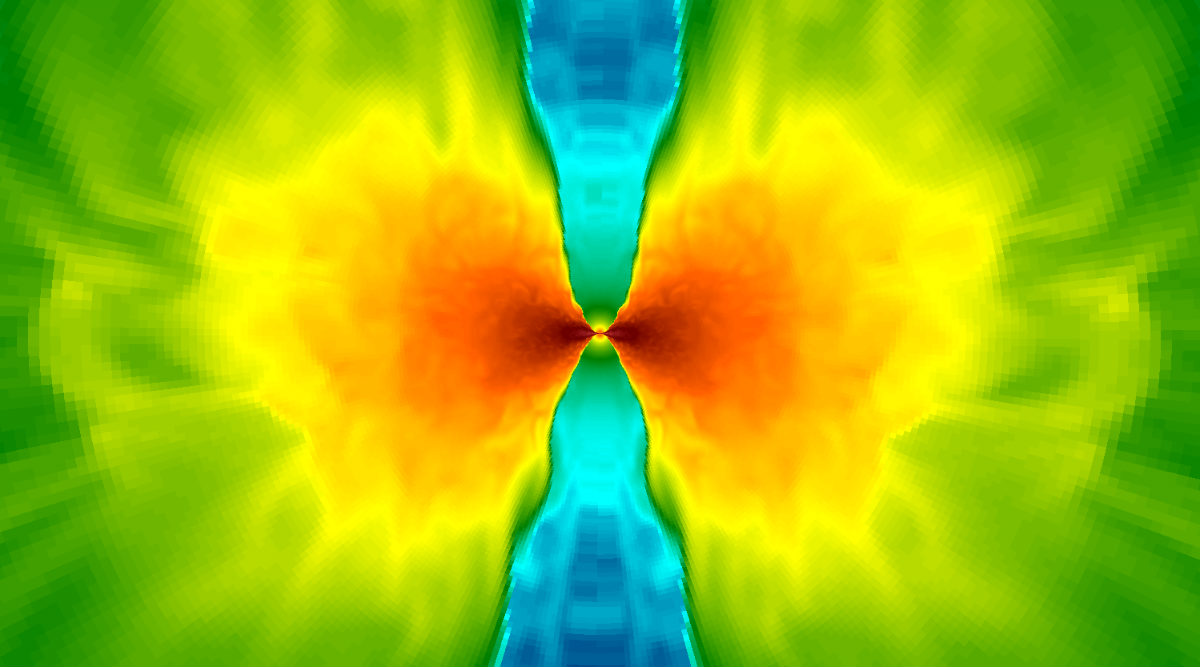
A cross section of the model of the colliding neutron stars shows the dense regions of the accretion disk in red around the black hole at the very centre. The astrophysical jet is the funnel above and below the black hole, a less dense region of blue, which gave rise to a gamma-ray burst. Photo credit: Rodrigo Fernández
The aftermath of the collision of two neutron stars has been fully captured in a 3D computer model for the first time thanks to research by University of Alberta astrophysicist Rodrigo Fernández and an international team. The achievement has lead to a better understanding of the cosmic collision, showing how heavy elements like lead and gold are created and accounting for a phenomenon missing in other models.
Neutron stars are the smallest and densest stars, mostly made of elementary particles called neutrons. In August of 2017, scientists detected the collision of two neutron stars for the first time by using the Laser Interferometer Gravitational-Wave Observatory. When two of these stars collide, they merge in a flash of light and debris known as a kilonova, as material explodes outward.
"The collision creates heavy elements, including gold and lead," said Fernández, who is an assistant professor in the Department of Physics. "In addition, we also saw for the first time a gamma ray burst from two neutron stars colliding. There's a large amount of science coming out of that discovery."
One of the important elements of studying the collision is the accretion disk-a collection of leftover debris that orbits the combined hyper-massive star-a cosmic footprint of the collision event. The material launched by the accretion disk should match up with the amount of matter that plays a part in the kilonova, helping scientists better understand the event.
The problem? The numbers haven't added up-the kilonova was brighter than predicted by current models; meaning some of the material hadn't been accounted for. That's where Fernández' research comes in, using computers to model the accretion disk to gain a better understanding of where everything ends up.
A cosmic conundrum
Modelling the event was no easy task. The first issue is that while the collision of the stars happens over the course of milliseconds, the disk can last for seconds; which means simulations take thousands of times longer.
The second problem is that the physics of the accretion disk are complex and involve a large number of different physical processes, including nuclear reactions given the extremely high temperatures at play. But one process makes the model more challenging than any other.
"Among the processes at work, the main culprit is actually the magnetic field acting on the matter," said Fernández. "We know the equations that describe that process, but the only way that we can properly describe them is in 3D. So, not only do you have to run the simulation for a long time, you also have to model it in three dimensions, which is computationally very expensive."
Leaving on a jet
The work has paid off, though. The work demonstrated that when simulations include magnetic fields, the disk ejects twice the amount of material and at higher speeds compared to when these fields are not included.
By modelling the aftermath of the collision in such detail, Fernández and the team have been able to account for both the accretion disk and another way matter is ejected from the collision: carried on an astrophysical jet, a narrow plume of particles and radiation shot out at nearly the speed of light as the stars collide, which is also thought to be the source of the gamma ray burst.
"The simulation's technical aspects are impressive from a scientific standpoint because the interactions are so complex," said Fernández. "It was expected that we could find jets, but this is the first time that we've been able to model this in enough detail to see this effect emerge."
This research was enabled by computational resources at the U.S. National Energy Research Scientific Computing Center. The paper, "Long-term GRMHD Simulations of Neutron Star Merger Accretion Disks: Implications for Electromagnetic Counterparts," is published in Monthly Notices of the Royal Astronomical Society (doi:arXiv:1808.00461v2).